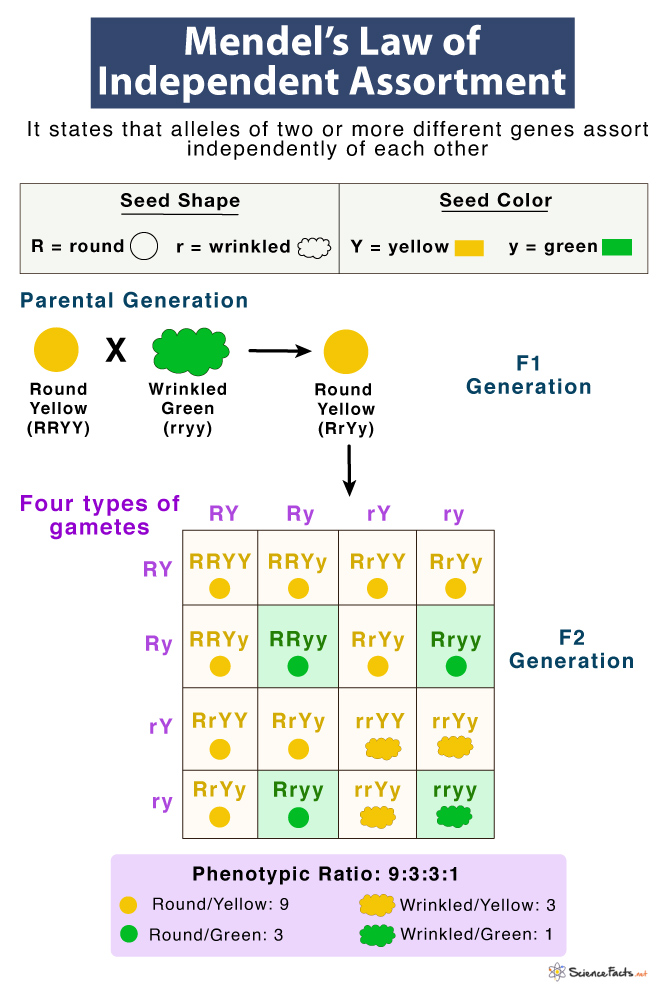Mendel’s Law of Independent Assortment
After the law of segregation that explains the inheritance of a single characteristic related to one gene, Mendel questioned how characteristics related to two or more different genes get inherited. He found that inherited genes assort independently of one another, which Mendel put forward as the law of independent assortment.
Law of Independent Assortment
The law states that alleles of two or more different genes separate independently from the other into gametes that reproduce sexually. Thus, the allele received from one gene does not influence the allele received from the other.
Example of Independent Assortment
In 1865 while studying pea plants involving dihybrid crosses, Mendel found that the traits in the offspring did not always match the traits in the parental organisms.
He crossed two pure-breeding pea plants in his experiment: one with yellow, round seeds (YYRR) and one with green, wrinkled seeds (yyrr). By the law of segregation, the gametes made by the round, yellow plant are all RY, and the gametes made by the wrinkled, green plant all are ry. Thus, all the F1 offspring are RrYy that are phenotypically identical, producing yellow and round seeds.
In the F2 generation, Mendel self-pollinated all F1 plants. He found four categories of pea seeds: yellow and round, yellow and wrinkled, green and round, and green and wrinkled. They were found to be phenotypically in the ratio of 9:3:3:1.
This ratio confirms Mendel’s law of independent assortment as the result of 9:3:3:1 is expected to produce four types of gametes with equal frequency: YR, Yr, yR, and yr. The result is explained when each gamete randomly receives a Y/y allele or R/r allele in separate processes, making four equally probable combinations. Thus, the chance of forming gametes with the gene R/r or Y/y is 50:50.
The result showing the 16 equally likely genotypic combinations are represented in a 4 × 4 Punnett square, where the gametes are arranged along the top and left. The 9:3:3:1 phenotypic ratio can be divided into two separate 3:1 ratios, showing a dominant and a recessive pattern of a monohybrid cross. Considering only seed color, we expect three-quarters of the F2 offspring to be yellow and one-quarter to be green. Similarly, considering only seed texture, we expect three-quarters of the F2 offspring to be round and one-quarter to be wrinkled. Thus, the sorting of alleles for color and texture are separate events.
Thus, the proportion of round and yellow F2 offspring is expected to be (3/4) × (3/4) = 9/16. In contrast, the proportion of wrinkled and green offspring is (1/4) × (1/4) = 1/16. Similarly, the proportion of round/green and wrinkled/yellow offspring is expected as (3/4) × (1/4) = 3/16. This result is identical to that obtained in the 4 × 4 Punnett square.
Why Independent Assortment Happens
The independent assortment forms the basis of meiosis I during gamete formation when homologous pairs line up in random orientations at the middle of the cell as they prepare to separate. At the end of cell division, we can get gametes with a combination of genes from both parents.
For genes on different chromosomes, such as in pea plants, the genes for seed color are on chromosome 1, while the genes for seed shape are on chromosome 7, and they assort independently. Also, genes far apart on the same chromosome assort independently due to crossing over in meiosis I.
Independent assortment is also critical in recombination, where pieces of genes from the parent’s mix and match, ensuring that genes assort independently from one another.
What Happens If Genes do not Follow Independent Assortment
Sometimes, when genes are very close to each other in a chromosome, they do not assort independently. The alleles on the same chromosome are more likely to be inherited as a unit. Such genes are said to be linked and do not exhibit independent assortment. In such cases, the genes for the color and shape of the seed are always inherited as a pair. Yellow and round alleles and green and wrinkled alleles always stayed together.
Rather than giving a separate color allele and a shape allele, the F1 hybrid gives one same unit for each gamete: a YR allele pair or a yr allele pair. One can use a Punnet square to predict the result of self-fertilization of the F1 offspring in such a case.
Suppose the color and shape genes were inherited as a unit or are entirely linked. In that case, a dihybrid cross will form two types of offspring, yellow/round and green/wrinkled, in a 3:1 ratio, which is different from the 9:3:3:1 obtained from Mendel’s experiment. This result of 3:1 further proves independent assortment during sexual reproduction.
-
References
Article was last reviewed on Wednesday, April 26, 2023




